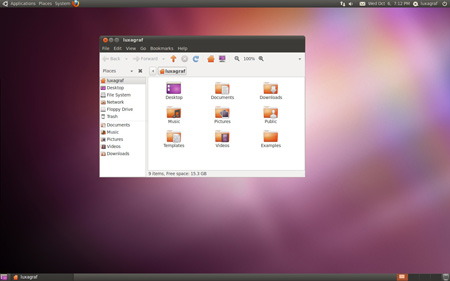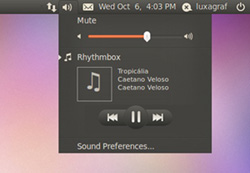Original URL: https://www.theregister.com/2010/10/11/ubuntu_10_10_review/
Ubuntu 10.10: date with destiny missed
Cosmetic polish ignores partition pain
Posted in OSes, 11th October 2010 06:00 GMT
Review Canonical delivered the latest version of its Ubuntu Linux distribution on October 10. Releasing Ubuntu 10.10 on 10/10/10 might seem an auspicious idea, but after the overhaul that was Ubuntu 10.04, the latest release looks tame by comparison.
While there is little in Ubuntu 10.10 that will knock anyone's socks, it makes for a solid update and continues Ubuntu's push to take on not just Windows, but Mac OS X as well.
The first thing you'll notice on a fresh install of 10.10 is the installer has once again been revamped, though the changes are for the most part cosmetic. The various slides that give new users information about Ubuntu have been tweaked and some menus appear to have changed. Unfortunately, the actual install process proceeds as usual - a fact that means dumping everything onto a single partition.
While that may be fine for some users, Fedora and other distros have long since switched to multiple partitions that separate your home folder from the system files. Fedora manages to do this without any user input and - for a distro that claims to be focused on being user-friendly - Ubuntu's failure to automatically partition seems an egregious oversight.

Subtle, not radical, improvements make for a nice default
Naturally, partitioning is easy for advanced users who know what they're doing and opt to customize their installs, but for those just clicking on the defaults, partitioning won't happen and that's a shame.
Ubuntu may be pushing Ubuntu One as a backup and recovery solution, but assuming everyone will use it seems naive. Ubuntu needs to stop fiddling with the installation screens and improve what the installer is actually doing, putting user and system files on separate partitions.
Once you've booted up, you'll see while 10.10 doesn't look radically different from the previous release it does have a number of very subtle improvements that make the default theme a bit nicer. Application windows sport smoother gradients, window buttons have been enlarged and refined, and the default Humanity icon set has seen a slight makeover.
Overall, Maverick's default theme is really what 10.04 should have been - more polished and refined with a greater attention to details. Ubuntu it seems is taking up Apple's longstanding belief that details matter.
Other parts of the Ubuntu interface have seen makeovers as well, like the revamped sound menu that features a nicer looking slider and says what track is playing along with the basic play/pause and skip buttons - a bit like Rhythmbox's minimized view living in your top panel.
The release also sees the inclusion of a new Ubuntu font that serves as the default for applications, desktop and window titles. The font is a step up from the old Sans font that used to be the default, though font aficionados are unlikely to be bowled over by it.
Software-Center redesign
Perhaps the most noticeable design change in Ubuntu 10.10 is the Ubuntu Software Center, which has some new features like a History option in the side menu, showing all package installations, removals, and upgrades by date.
There's also a controversial new proprietary software portion section in the Software Center. At the time of writing, there were no apps for sale, but there were some wallpapers included for testing purposes. Unlike the beta release, where I was never able to get to a purchase screen or even login for that matter, this time everything worked as advertised.
Eventually, the plan is for commercial Linux software to be purchased and installed right alongside the familiar free options, but for the initial launch of Ubuntu 10.10, the options will likely be limited to only one package - Fluendo's DVD player application. It remains to be seen if Ubuntu can attract large developers to the platform, but certainly, providing an easy way to sell their apps is a step in the right direction.
Purists beware
Free software purists may decry the move, but Canonical clearly doesn't care and is ultimately more interested in a free desktop that allows the users to install any kind of software applications they'd like than it is in satisfying the militantly free crowd.
The new Software Center purchasing interface isn't the only thing that finally worked correctly. The online file storage and sync service Ubuntu One has been vastly improved and - for the first time since it was launched - actually worked without issue for me.

Name that tune: playing tracks now identified
And that's welcome news because Ubuntu One has some big changes coming with the release of Ubuntu 10.10 including the new Ubuntu One Mobile. Ubuntu One Mobile will handle a number of tasks, like syncing contacts to your phone, but the most interesting is the new music streaming service. Ubuntu One Mobile, which cost $3.99 USD a month (or $39.99 USD a year), will allow you to stream any music you've stored in Ubuntu One to your Android or iPhone. Applications for both platforms are still in the works (and in the iPhone's case subject to Apple's notorious approval process) but the service certainly sounds promising.
Ubuntu One has updated its pricing plans too, with a new tiered structure that allows you to add gigabytes of storage in 20GB increments for $2.99 (USD) per month or $29.99 (USD) per year.
Verison 10.10 brings the usual slew of GNOME software updates with the Evolution mail client being the most noticeably different - it's quite a bit snappier than the version that shipped with previous release. Also, Shotwell replaces F-Spot as the default photo editor. Shotwell is nearly on par with F-Spot these days, though if you're serious about photography take a look at our Linux photo apps roundup for some other choices.
Another small, but nice new feature is support for multi-touch gestures on supported trackpads. In the beta versions of Ubuntu 10.10 that meant Dell's XT2 laptop with support for Apple's Magic Trackpad to arrive later. In the version I tested, multi-touch wasn't pre-installed, though the app Utouch was available in the repos. Unfortunately, I was unable to get it working with the Apple Trackpad. If you happen to have an XT2 then the gesture support reportedly works well. If not, well, perhaps 11.04 will bring some improvements.
All of the various Ubuntu spin-offs will also see updates this weekend, including Kubuntu, which will move to KDE 4.5.1 and merges the Desktop and Netbook images into a single image that will boot into either the Plasma Desktop or Plasma Netbook workspace based on your hardware (the setting can be manually set as well).
Netbook look
The Ubuntu Netbook derivative sees the arrival of the new Unity interface, which is adapted to fit smaller netbook screens. The global menu has been redone to optimize vertical space on small screens and applications are automatically maximized by default.
Other welcome changes include a date and time indicator with a real calendar widget and a tweaked version of Evolution that actually fits on a netbook screen.
Although a regular Ubuntu install on a netbook works just fine - at least on my EeePC - the netbook edition does offer screen size advantages, and now that the Unity interface has more or less reached feature parity with its desktop sibling, there's really no reason not to use it.
Overall Ubuntu 10.10 is a worthy, if somewhat boring, update that polishes and refines some of the big changes that arrived with 10.04 earlier this year. The interface has been improved with some welcome attention to the small things, but if you're looking for major new features this release may well disappoint you. ®